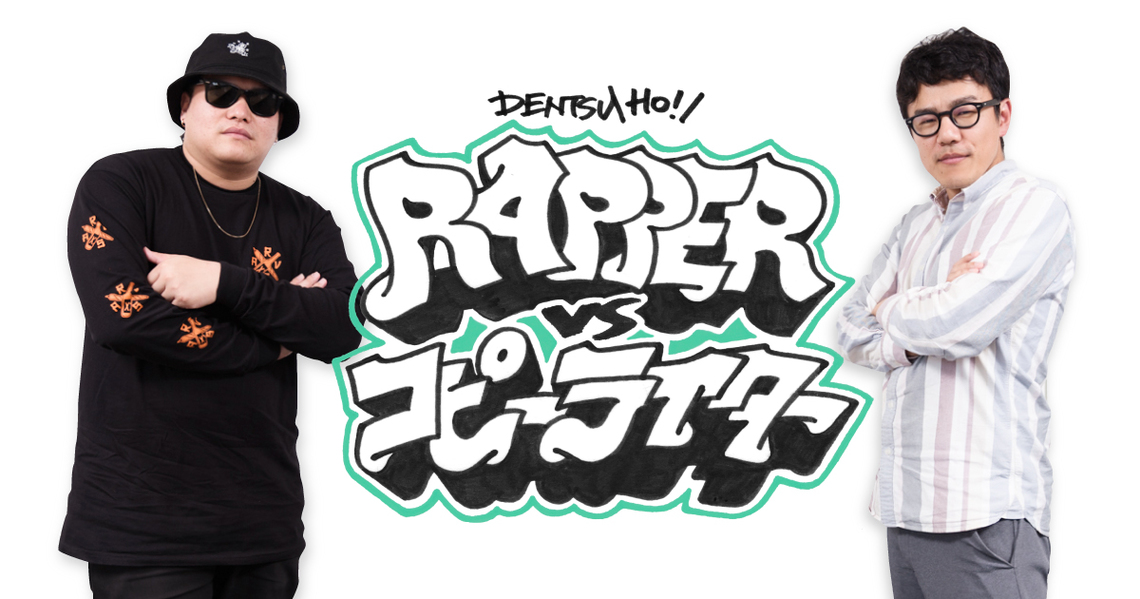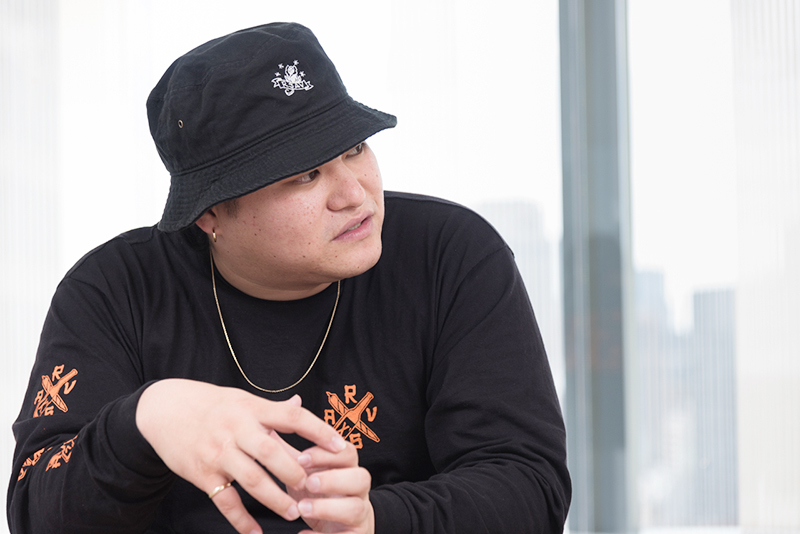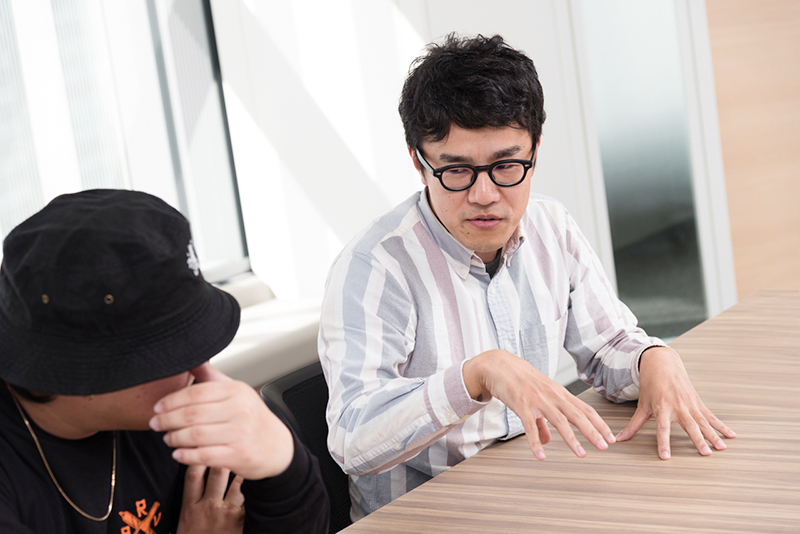Note: This website was automatically translated, so some terms or nuances may not be completely accurate.
Snufkin × Kunihiko Mishima: We work jobs where we don't have to wear suits.
The appeal of freestyle rap battles taking the world by storm. It's not just about the overwhelming passion of the participants. One reason they capture the hearts of young people lies in the clever exchange of rhymes. A rapper on the rise with machine-gun-like rhyming skills. Opposing him is a copywriter who calmly crafts "long-lasting," essential copy. These two, though the same age, are starkly contrasting figures who discovered both their differences and common ground.

Deep in the anarchic world where ties are unnecessary
Snufkin: Why did you decide to become a copywriter?
Mishima: It was a rather impure motive. At the time, Yoshiteru Sawamoto from Dentsu Inc . came to my university every week to teach an advertising class. I took it casually, but I remember being strangely drawn to the idea that "advertising work doesn't require wearing a suit." Then, I found it fun to twist and turn words for class assignments, and that's what sparked the thought, "Wouldn't it be great if this became my job?"
Snufkin: I totally get the "don't want to wear a suit" reason (laughs). I started rapping in a group, and when my friends quit one by one and I was left alone, that's when I seriously decided to become a rapper.
Mishima: I don't listen to much music myself.
Snufkin: Radio?
Mishima: Yeah. Radio or rakugo.
Snufkin: I knew it. I don't listen to hip-hop at home either, just radio. AM, right?
Mishima: I love TBS Radio's late-night slots, especially Ijūin Hikaru's show. It's reassuring to hear how many people out there come up with shockingly pointless yet hilarious ideas – it makes you think this world isn't so bad after all. I listen with the lights off (laugh).
Snufkin: I'm also a lights-off guy (laughs). Words sink in better that way. Late-night radio is insane—the pauses between words and that anarchic vibe.
Mishima: It's interesting how it's about the relationship with the listeners, or rather, that anything goes. Radio fades away with the sound, so it leaves less evidence than magazines or TV. It's like freestyle rap, isn't it?
Snufkin: Definitely. I'm the type who doesn't want freestyle battles recorded.
Mishima: You don't like having battle videos uploaded?
Snufkin: Sometimes the lyric captions are wrong, and even if they're right, I don't think they need to be preserved. For example, there's no footage of MC battles around 2000 when KREVA won, or that era when MC Kan was incredibly strong. You just hear rumors about how insane it was. Freestyle battles are about that instant call-and-response, so I think it's enough for only the people there to share that moment.

Mishima: Ijūin-san says the essence of being a radio personality is "authenticity, including the things you can't articulate well." Since it's live, the flow might stumble sometimes, but that's part of sharing the situation with the listeners. A good personality isn't just someone who speaks fluently. Perhaps all forms of expression have more reality when they're not overly polished.
Snufkin: The real thrill of late-night radio and freestyle rap is their freedom and immediacy. It's not about ties, but being unbound is what makes it interesting. Rakugo has that quality too, right?
Mishima: I go to solo performances by rakugo artists I like, and enjoy CDs and DVDs of legendary Showa-era masters or the late Master Tachikawa Danshi. There are also stenographic books of rakugo, so I read them in book form too.
Snufkin: I mostly listen to CDs, but I find the way they structure the story—the build-up, the climax, and the payoff—really instructive.
Mishima: My favorite story, "The Well Bowl," has such a brilliant punchline—it's pure satisfaction. The appeal of rakugo is how it builds an entire world using just words, right? Just listening stimulates your brain. Has rakugo influenced your rap, Snufkin?
Snufkin: If I consciously tried to use rakugo for rap, I wouldn't enjoy it purely, but I think it's influenced me to some extent.
The greatest and most universal rhetorical device for "making you care"
Mishima: I hadn't listened to much rap before, but I thought Snufkin-san's lyrics had a lot of rhyme. There's a musical pleasure, or addictiveness, in those repeated sounds.
Snufkin: I use rhyme to create a groove with words.
Mishima: I studied English literature and Shakespeare in college. Shakespeare's brilliance actually lies in his rhymes—his sentences are beautifully structured as sound. In terms of delivering words as sound, rap might be a universal culture that connects even to Shakespeare.
Snufkin: When the sound aligns, it just feels good to listen to. Compared to Japanese, where you can only rhyme with vowels, English offers more freedom. Back in the day, I'd line up Japanese words I knew on the left and English words I looked up on the right to find rhymes. I'd break the Japanese sound and rhyme using an English-like pronunciation.
Mishima: That's an interesting technique. For copy used in commercials, where wordplay and sound are crucial, rhyme is a powerful tool. "Hokkaido. Big and bold." That kind of copy is the perfect example, isn't it?
Snufkin: Advertising copy teaches you how to use paradoxes and metaphors to make people stop and take notice.
In battles, besides rhymes, we also quote classic punchlines or opponents' words out of respect, or use self-boasting to make ourselves look bigger and provoke the other side. Are there various rhetorical devices in copywriting too?
Mishima: Regarding advertising copy rhetoric, I believe every means is fair game. Among all forms of writing, advertising might be where the most intricate techniques are employed. The copy from the 1980s is truly impressive. However, lately, sophisticated rhetoric tends to be avoided because it can be dismissed as "too intellectual."

Snufkin: Technique is important, but if you don't grab their attention, you lose, right?
Mishima: Creating entirely new words is difficult, so it's about discovering novel combinations of existing words.
Snufkin: I was at a local family restaurant, and there were these stylish gals. One said "Pinee," so I asked what it meant. She explained, "P comes after P, so it's better than 'Pane'!" (laughs).
Mishima: That's the kind of thinking only they can come up with. For me, it's more like I agonize over it, scribble down words, and then search through them.
Snufkin: When you write copy, do you transcribe it into text? With rap, flow is crucial, so I record myself to remember the phrasing and intonation.
Mishima: I'm the type who reads the text and recites it in my head. Even for ads without narration, I aim to write copy with a pleasant rhythm and resonance.
Snufkin: Copywriting words are short, aren't they?
Mishima: Commercials have time constraints, so it's around 12 to 20 characters.
Snufkin:Aquarius commercials use just one kanji character, right? Like "Challenge" or "Passion" – one of them applies to your situation. Each scenario unfolds, concluding with "Because people get really thirsty." Using the characters as a subliminal effect, deliberately not saying everything – that's what I thought was clever.
Mishima: The art director conceived the mechanism of amplifying human imagery through the combination of a single kanji character and an emotion. When emotions surge intensely, people experience a sensation akin to physiological thirst. That moment is captured with a single character and imagery, highlighting Aquarius's essence: "quenching human thirst."
Snufkin: Choosing "Thirst" over "Moisture" and transforming a negative image into a positive one was also brilliant.
Mishima: "Moisture" would feel too natural, making it hard to grab attention.
The crucial difference between whether it's coming from me or not
Snufkin: Lately, freestyle rap's gained recognition, and I get requests like "Promote this product through rap." But unless I'm genuinely interested, the words just won't come. I'd take on sunglasses ads, though (laughs). Copywriters handle such a wide range of work, right?
Mishima: Even if I were to get a job for something I have absolutely no interest in, I think the interesting part might be researching why it was created and what the people who make it or buy it are feeling.
Snufkin: How do you research it?
Mishima: First, I think about it objectively based on my own life experiences. When would someone want this? Then I gather words and reactions from the internet, or ask people close to me, "What do you think about this?" In a way, I think copywriters are like mediums – we have to be able to embody the feelings of any client or person.
Snufkin: That reminds me of the rapper Eminem, who created music under the persona Slim Shady. In interviews, he'd say, "Ask Slim Shady, not me." I sometimes write lyrics in a storytelling style, pretending someone else is writing them.

Mishima: The difference between rappers and copywriters might be whether the speaker is themselves or someone else.
Snufkin: That's true. Copywriting work is generally quite anonymous, after all. Rap is fundamentally about freely expressing your own thoughts.
Mishima: It's incredible that something can emerge from a state of near-total freedom. Especially in battles, where it's completely improvised with no script.
Snufkin: Even though it's called freestyle battle, there are rules, and some say it's not completely free. No constraints can actually feel restrictive. But if I go first and my opponent is a rapper I don't know, it's tough. I have nothing to say.
Mishima: What do you do in those situations?
Snufkin: Either I talk about my hip-hop philosophy and attitude to distance myself, or I throw it back at them with "What about you?"
Mishima: I see. Snufkin's rap has such a clear stance; it gives the impression, "This person is trustworthy." The freedom of words you can use is different from advertising, so there's a reality we can't capture. It really made me feel that what advertising can depict is only a part of the world.
Words that create a momentary burst of intensity, and words that endure
Mishima: Even within the album " Welcome to Bedtown," you use various expressions and words while still focusing the story on your hometown, the Saitama bedtown. Each chapter builds toward a climax, like a movie structure.
Snufkin: Lately, I've started thinking about storytelling when making albums. I want people to listen to the album as a whole, so I don't offer digital downloads where you can get individual tracks.
The video for your work, Kesennuma Knitting, was long and cinematic, wasn't it? It had this butterfly effect quality. I felt a consistent narrative thread: knitting warms people, warms the town, warms the world.
Mishima: My personal theme for that video was to beautifully document the knitting process and support the knitters.
Snufkin: I used to think it was cool to hide the background and effort, just smoothly pulling off something amazing. I even made a song dissing cypher (laughs). But seeing that video made me realize showing the behind-the-scenes side can be good too. Knowing the backstory makes it hit even harder.
Mishima: When I heard that Mr. Mitarai, the president of Kesennuma Knitting, said he wanted to make a video, I knew I absolutely had to be part of it. Knitting has always been thriving in Kesennuma. Fishermen knit on their boats, and families knit at home. Some people even learned knitting from their grandfathers. Hand-knitting doesn't require factories; it can be done anywhere. That's precisely why we focused on presenting the brand as one that produces high-quality goods, regardless of its location as a disaster-affected area. We wanted people to understand the story rooted in the brand.

Snufkin: So you deliberately cut out the tear-jerking parts.
Mishima: Our greatest asset is our knitters, so we wanted to create something they could be proud of.
Snufkin: Where exactly is that being shown?
Mishima: It was played at department store events. People seem to feel like buying something when they see it, which makes me happy.
Snufkin: It's something that will be seen for a long time, rather than just being hyped for a moment.
Mishima: Copywriting has two purposes: boosting momentary buzz and capturing the essence. For the former, there are numerical goals—like tweet counts on Twitter or video views. I aim to create copy that isn't easily discarded, that lasts.
Snufkin: For me, the buzz comes from freestyle rap, while the essence is in the recorded work. That core part has an uncompromising artistic stance. Do you check online or Twitter reactions after an ad goes live?
Mishima: I learn a lot from the internet, but it really depends on the job. I'm not saying it's okay if it doesn't become a topic, but I also feel that if the message you want to convey gets through to the people you want it to reach, that's probably the best outcome. What about you, Snufkin?
Snufkin: I check to some extent. The more haters, the higher the status. If they're taking the time to speak up, it means they've seen it at least once and it's on their mind.
Mishima: So both buzz and substance have their own roles and meanings, right?
Produced by: Shunsuke Kaga
Title Calligraphy: Kengo Aoki
Rapper Selection: Taika
Was this article helpful?